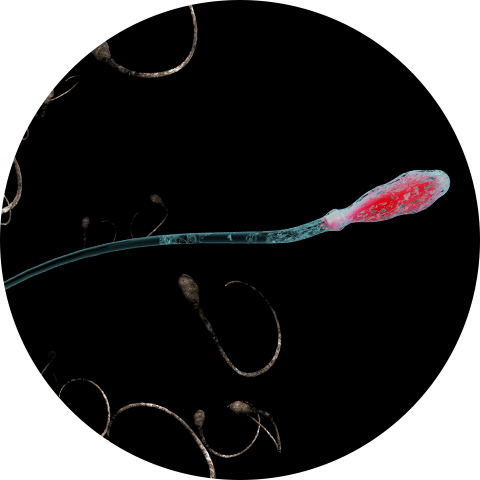Infertility
Infertility
Infertility is defined as not being able to get pregnant after one year of unprotected sex. The main symptom of infertility is lack of pregnancy without any pronounced symptoms. According to the American Society for Reproductive Medicine, one third of the case is due to the female fertility factors. The other one third is related to the male fertility factors and the remaining one third is due to the combination of factors from both partners. In addition, we treat both men and women for fertility.
To get pregnancy, several things must happen.

- ovulation needs to occur.
- The female patient needs to have regular menstrual cycle activities.
- Male partner needs to have healthy viable sperm.
- The sperm must fertilize from the woman’s cervix to the uterus and travel through the fallopian tube to meet and fertilize the egg.
- The fertilized egg must implant to the endometrium.
The most important cause of female infertility is age!!!
The graph above shows the change in pregnancy rate and egg quality according to women’s age.
Naturally, as women age, the pregnancy rate decreases. When they reach the age of 35, the pregnancy rate decreases significantly, and the average pregnancy rate reduces by 10% at the age of 40 and 1% at the age of 45.
The biggest reason why the pregnancy rate decreases as a woman get older is.
01
Unlike male sperm, female eggs are not newly created, and the number of eggs they had at birth gradually decreases as they repeat ovulation and degeneration.
02
This is because eggs stored in women’s ovaries for decades are more likely to develop chromosomal abnormalities in the process of division as time passes.
Hormones and Infertility
Several hormones work for fertility. Problems with the working of these hormones interfere with pregnancy. Infertility-related hormones include thyroid hormone, prolactin, follicle-stimulating hormone, and luteinizing hormone. Blood tests can identify to check for abnormalities of these hormones, among which female hormones must be performed on the 2nd to 3rd day of menstruation to obtain accurate test results.
Follicle-stimulating hormone (FSH)
Follicle-stimulating hormone (FSH) helps control the menstrual cycle and egg production. FSH levels are tested on day 2 or 3 of the menstrual cycle to determine a woman’s ovarian function and evaluate egg quality.
In general, women with elevated FSH levels found in their blood on day 2 or 3 of the menstrual cycle have reduced chances of live birth compared to other women of the same age, even with ovulation induction and IVF.
Estradiol
In conjunction with the FSH test, a woman’s ovarian function and quality of eggs can be evaluated through testing estradiol, an important form of estrogen. This test is also performed on day 2 or 3 of the menstrual cycle.
The results of these tests are not absolute indicators of infertility, but abnormally elevated levels correlate with decreased response to ovulation induction medications, and thus lowered IVF success.
Luteinizing hormone
Luteinizing Hormone (LH) stimulates the ovaries to release an egg and start producing progesterone – a hormone that prepares the uterine environment to nurture a fertilized egg. LH can be found in a woman’s urine just before ovulation occurs. Over-the-counter tests that help predict ovulation measure this increase of LH via a urine sample. Urinary LH testing is commonly used to help time intercourse in order to improve pregnancy chance.
Progesterone
The ovaries produce the progesterone hormone just after ovulation. At about mid-cycle – 12 to 16 days after the first day of the menstrual cycle – progesterone prepares the uterus for a fertilized egg’s arrival.
Progesterone levels generally peak one week after ovulation and can be measured through blood tests to detect the amount of progesterone present in the blood stream. After establishing a baseline of progesterone in the blood, a doctor will obtain a mid-luteal serum progesterone test around day 21 of the menstrual cycle or, if urinary LH predictor tests show a positive surge consistent with ovulation, seven days after this test is positive.
BBT Chart
By estimating the ovulation date with the BBT chart, you can find out when you can get pregnant and determine whether you are ovulating.
The rise in body temperature is evidence of progesterone’s smooth secretion. The endometrium secretes more mucus by the progesterone, creating a favorable environment for the fertilized egg to be implanted.
However, suppose the fertilized egg is not fertilized or implanted. In that case, the luteal body atrophy and the progesterone decrease after about two weeks, causing the endometrium to peel and fall, and menstruation begins.
Thyroid Stimulating Hormone
The hormone plays an important role in the proper development and implantation of eggs.
Thyroid Stimulating Hormone(TSH) should be part of the routine evaluation of recurrent pregnancy loss and infertility. TSH should be part of the evaluation for infertility. Here is why: A TSH level of 5mU/l or greater is indicative of hypothyroidism. A TSH level less than 5 mUl but greater than 2.5mU/l is associated with implantation failure and early pregnancy loss. A recent study published in the European Journal of Obstetrics and Gynecology and Reproductive Biology in 4,643 women who had thyroid function tests performed when pregnant found a TSH level in the hypothyroid range in 1.5% of women and 10.3% had a TSH between 2.5 mU/l and 5mU/l. Approximately 19% of women with a TSH higher than 2.5 mU/l but less than 5mU/l went on to develop clinical hypothyroidism. Women with a TSH greater than 5 mU/l delivered infants of low birth weight.
* TSH should be determined and treated if found to be over 2.5 mU/l. The TSH level should be reassessed in early pregnancy since there is increased utilization and demand for thyroid hormone in early pregnancy. The dosage usually needs to be adjusted by as much as 20% to keep the TSH level less than 2.5 mU/l.
Here is how to measure your basal body temperature:
1. The basal thermometer should be used exclusively for basal body temperature, not a general thermometer or electronic thermometer.
2. Wake up in the morning and put the thermometer in your mouth without moving for about 3 minutes.
3. It is essential to measure daily, and all-important items (menstruation, sex, medication administration, and other health conditions) should be recorded.
4. You can save time by measuring at least two months in advance to get infertility treatment.
What Causes female infertility?
Ovulation
Disorders
Fallopian Tube
impairment or blockage
Uterine abnormalities
or cervical abnormalities
Fertilized egg
implantation disorder
Pelvic inflammation
or adhesion
Chronic disease or
immunological factors
Women are responsible for both pregnancy and childbirth, so female infertility is more diverse than male.
Finding the cause of female infertility may include six types.
What causes Male infertility?
Men’s fertility rate is highest at about age 25 and decreases significantly after age 45. However, men, unlike women, do not entirely lose their ability to conceive in old age.

Sperm abnormality
The cause of infertility on the male side is the inability to send fertile sperm into a woman’s genitals.
The specific causes are as follows.
01
Low sperm
production
02
Sperm production
abnormalities
03
Impairment of
sperm transfer
process and closure
of sperm transfer
pathways.
04
When ejaculation
is not possible
in a woman’s vagina
due to erectile
dysfunction,
ejaculation disorder,
etc.
Male and Female causes infertility
More than 10% of all infertile couples are diagnosed with unexplained infertility.
There are no abnormalities in the male’s semen, and there are no female problems. Unexplained infertility in which conceive does not occur, there is a possibility of infertility due to immunity.
Semen or substances in sperm become antigens and make antibodies in a woman’s body, which then affects the sperm or inhibits conception.
Also, antibodies to sperm are presenting on the surface of men’s sperm or in the semen, cause the sperm to malfunction and in consequent, it interferes with conception.
Both men and women can make anti-sperm antibodies.
Immune infertility is not yet clear.
There are several stages to be conceived, but it becomes difficult to get pregnant if there are any problems at each step.
The causes of infertility are complex, so try to find solutions for various reasons.
What is Recurrent Spontaneous Abortion?
After fertilization of sperm and egg, only about 30% of pregnancy reaches a complete pregnancy. That is called as a period of complete stability.
Spontaneous miscarriage is the most common complication during pregnancy, and the spontaneous abortion rate before 20 weeks of pregnancy is around 10-12%.
Before the 20th week of pregnancy is three or more times of spontaneous abortion rate is 0.3%.
What causes spontaneous abortion?
Genetic cause
The only clearly proven cause of habitual miscarriage is parental chromosomal abnormalities (3-5%), with balanced translocation of either or both parents being the most prominent part.
Anatomical cause (10%)
It can be caused by congenital uterine-shaped malformations or acquired fibroids, endometriosis, endometrial adhesions, or cervical asthenia.
Endocrine cause (17%)
Often there is a luteal phase defect, thyroid disease, or diabetes.
Infection (5%)
It is associated with chlamydia, herpes virus, and toxoplasma infections.
Why do you need MBR Acupuncture & Herb treatments for infertility?
The MBR Acupuncture & herb treatment strengthens ovarian function, facilitates ovulation, and helps improve the quality of the egg. MBR treatments help strengthen ovarian functions and increase AMH levels. It also helps implantation through treatments that strengthen the endometrium, improve the uterus’ environment, and warm the abdomen and uterus. MBR treatment helps make the uterus healthy by removing blood stagnation and damp-phlegm, which interfere with implantation. We understand the body’s fundamental condition that makes pregnancy difficult and makes a treatment plan considering life and environmental aspects to help a healthy pregnancy. MBR treatment can help them conceive of making high-quality eggs during the IVF procedure.

IVF with MBR Infertility Acupuncture and MBR herb Treatments
The success rates of IVF by age in the United States are as follows :
According to a source, the success rate of IVF can be increased up to 45% if IVF is treated with the oriental medicine. In addition, oriental medicine helps the nutritional status of the body and supports the ability to generate blood before and after the test tube, which is the basis for the healthy growth of the fetus. Most patients who have undergone implantation-promoting treatment experience improved egg quality and maturation of the endometrium. In result, implantation maintains stability and leads to successful test tube surgery and healthy childbirth.
Raise the implantation rate with the remedy taken during the IVF.
Effectively maintain pregnancy and increase the success rate of the IVF.